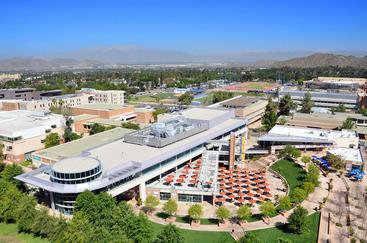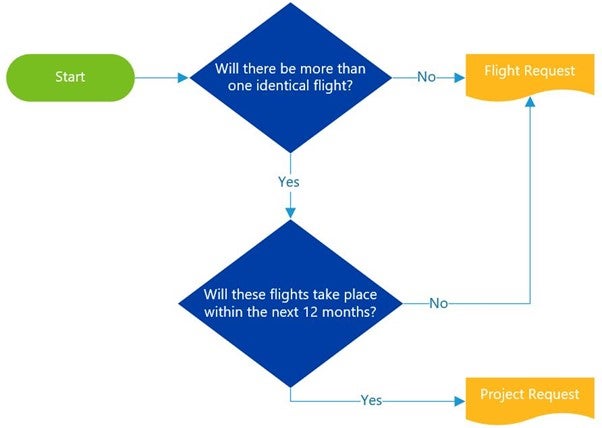Unmanned Aerial Systems (UAS) Program
The use of Unmanned Aircraft System (UAS), also known as drones, is increasing across the US and on university campuses. UCR is committed to promoting this new technology and supports the safe use of UAS for academic, research, and recreational purposes. The Unmanned Aircraft System/Drone Safety Program ensures that all UAS activities are conducted in a manner that protects students, faculty, staff, visitors, the public, property and the environment, and complies with all applicable laws, regulations, and policies.
All drone activity on campus or associated with UCR must follow the requirements of this safety program and must be in line with all the rules and regulations of the Federal Aviation Administration (FAA). Drone pilots must obtain a FAA license to operate a drone and all drones require registration with FAA.
On-campus indoor flights is restricted to specific labs and classrooms, but is not subject to FAA requirements. Indoor flights require an assessment of the intended flight space by EH&S.
Flights invovling UCR pilots and UCR-owned drones must request flight approval using the UC Drones application on Risk and Safety Solutions (RSS) suite. All other flights, including student-owned or hobby drones, must request flight approval as a 3rd party flight.
UAS cannot be flown on UC Riverside property without prior approval. Please use the UAS Flight Request form to submit a request.
Drones
-
Planning a Drone Flight
To ensure a safe and successful flight, plan ahead and prepare all the necessary information prior to submitting a drone flight request.
Planning a Drone Flight Includes:
- All flights must be operated by a FAA licensed pilot
- All drones must be registered with the FAA
- Detail description of proposed drone activity
- Crew management (including roles and responsibilities)
- Flight altitudes
- Flight distances
- Specific flight paths
- Ensure that the flight path does not take place in restricted areas (UC Drones application on the Risk and Safety Solutions suite provides maps outlining restricted airspaces)
- Identifying potential risks (see below)
- Emergency procedures
- Creating and marking buffer or safe-zones (a rule-of-thumb is to maintain a buffer of safe-zone roughly a fourth of the flight altitude)
- Fire safety training for all participants
- Avoidance of flying during high fire risk days
- Consider brining a fire extinguisher
Indoor Drone Flights:
- Most indoor flights are prohibited on campus with the exception of specific labs.
- Indoor flights for specific labs and classes are not required to obtain flight approval with the UC application.
- Indoor flights do not require FAA licensing for the pilot.
- Indoor flights may require adding controls, such as netting, to prevent impacting building structures (sprinklers, alarms, windows, etc.)
- It is strongly recommended that all participants involved with indoor drone flights done safety impact eyewear for personal protective equipment (PPE). Contact ehslaboratory@ucr.edu for more information on obtaining safety impact eyewear for drone use.
- Indoor flights require assessment of the lab or class space by EH&S to ensure that drone activity will not impact building structures. To request a space assessment with EH&S, contact ehslaboratory@ucr.edu.
Potential Risks to Consider:
- Weather conditions
- Structures not visible from satellite imagery (e.g. powerlines, telephone lines, recent construction, temporary structures)
- Intruding air traffic (constantly listen for potential incoming traffic)
- Intruding vehicles
- Intruding pedestrians or other non-participants
- Unplanned spectators, crowds, and/or activities
- UAS damage
When Operating a Drone:
- The drone should always be within the pilot's visual line of sight (VLOS) without the help of visual aids, with the exception of corrective lenses.
- The drone should not be flown directly above people.
- The drone should not be flown directly above moving vehicles or in-use roads.
- Flying over buildings may be restricted depending on building materials and privacy laws.
- The flight should stay within an altitude of 400 ft.
- It is strongly recommended to have visual observers (VOs) to assist the pilot and manage traffic near the flight.
- VOs may only act for one UAV at a time.
- It is strongly recommended that the crew wear high visibility reflective vests when operating near roads or near non-participants.
- It is highly recommended to use orange cones to communicate the flight area to non-participants.
- If spectators are expected, a supporting ground crew member should be tasked with preventing spectators from distracting the Remote Pilot in Command (RPIC) with questions or comments.
- When operating near roads, a supporting ground crew member should be tasked with being located near the road to monitor traffic and, if necessary, retrieve a fallen UAS before it becomes a road hazard.
- Practice judging an intruding aircraft's location by sound and use visual scanning techniques to identify an aircraft's location quicker.
- Minimize the time it takes to detect and assess a threat, to decide on a course of action, and to act.
- Flying indoors should take place within a netted structure so as to not impact sprinklers or other indoor structures.
- A laboratory hazardous assessment must be conducted prior to any drone usage inside a laboratory.
- Flying inside dorm buildings is prohibited.
When Drone Usage may be Restricted:
- Proximity to medical helipads
- Privacy concerns within 100 ft
- Expected heavy pedestrian or vehicular traffic at the intended time and date of the flight
- Impacts to wildlife
- Detrimental to university business
- Noise concerns at distances greater than 200 ft
- Risk of damage to outdoor equipment or facilities with drones under 4.4 lbs.
Note: A flight may not be rejected solely due to the risk level. High risk flights can be approved depending on the pilot's skill and experience, detailed consideration and demonstration of risk mitigation, expected activities in the intended flight area, go/no-go considerations, and likelihood-vs-consequence of potential risks. Consider the risk equation when assessing potential risks and threats.
Risk Equation:
Likelihood
Low
High
Consequence
Low
GO!
Go? Can this be mitigated? Are the crew able to detect and react to risks/threats that may occur?
High
Stop? It is best to avoid these. Can the consequence be lessened? If so, this could become a go.
STOP!
-
UC Drone Flight and Project Requests
The Risk and Safety Solutions (RSS) suite includes a UC Drones application, which is used to streamline drone registrations, flight approvals, and flight reporting. UC Drones and UC Drone Pilots need to have flights approved through the RSS system before the flight can take place. Approved flights are covered by the UC Drone liability insurance, which can help cover the cost of drone accidents and drone replacement. Because all flight requests must be approved before the flight takes place, it is recommended to submit flight requests a three (3) business days in advance to allow time for the request to be processed.
Do I Submit a Flight Request or a Project Request?
Important Notes About Project Approvals:
- All flights in the project still require a "request" in order to be covered by the liability insurance, however, the requests are automatically approved if the entire project has already been approved.
- All flights approved under the project must be identical to what is already approved in the project. Any deviation or differences need to go through a separate flight or project request.
- All UC pilots must registered through the RSS system.
- All UC drones must be registered through the RSS system.
- A separate flight report must be submitted for each flight approved under the project. To complete the flight report, click on the "Submit Report" button at the bottom of the approved flight request.
Flight Request Process (UC Drones):
- Register the UAS with the FAA .
- Register the UAS with the UC Drones application by clicking "Manage Aircrafts".
- Register the pilot registration on the UC Drones application by clicking the "Pilot" button.
- Complete a flight request on the UC Drones application by clicking "Manage Flights & Non-Project Flights" button OR complete a project request by clicking the "Manage Projects & File Project Flights" button. If flying under a project request, be sure to add flight to the project for each flight planned.
- Await approval for flight request. Some discussion may take place before receiving approval.
- Upon receiving approval, please fly safely.
- When the flight is completed, complete a flight report on the UC Drones application by clicking "Report on Approved Flights".
Access:
-
Non-UC Flight Requests/3rd Party Flight Requests
If the drone to be flown and the pilot are not affiliated with the UC, but the flight will be taking place on or within a UCR location, a 3rd party drone request will need to be completed. These requests are reviewed by the UC Drone Operations Manager to check the details of the flight, pilot license, and liability insurance. If all the documentation has met all the requirements, the UC Drone Operations Manager will check the details of the intended flight area and intended flight date and time. Due to the assessments and communication that must occur, it is recommended that all 3rd party drone flight requests be submitted at least three (3) business days in advance of the intended flight date and time.
3rd party drone pilots are required to have a drone license or a Part 107 waiver. 3rd party drone liability insurance will be required.
Click here to submit a 3rd party drone flight request.
-
Drone Incident Reporting
Common UAS accidents, incidents and malfunctions that need to be reported include:
- Operator error resulting in collision
- Loss of battery/fuel
- Loss of control of UAS
- Hardware malfunctions
- Improper "return to launch" location
- Improper UAS assembly
- Experimental hardware/software
- Hazardous weather conditions
- Battery fire from puncture or impact
Not all incidents require reporting. Accidents, incidents, and malfunctions that do not need to be reported:
- Malfunctions related to payloads that have no impact on safety
- Damage of components designed or expected to fail during regular use
- Rough or hard landings that do not result in damage
- Damage to UAS due to improper ground-handling/UAS
If there is an incident during a drone flight, take appropriate measures to manage the situation:
- Secure the site to prevent foot traffic from entering the area
- Extinguish fires, if possible
- Call emergency services, if needed
- Take photographs of the scene and provide as much detail as possible
- Complete the flight report on RSS and include as much detail as possible on the incident
- Expect to be contacted by the UC Drone Operations Manager or UCR's EH&S for incident follow-up and help with insurance.
- if the incident involved a 3rd party drone request, report the incident here.
-
Documents & Resources
- UC Drones on RSS Suite
- Becoming a Drone Pilot (Apply for a License or Waiver)
- FAA Drone Registration
- B4UFLY Mobile App (Provides interactive maps with information on where it is safe to fly)
- Report an Unauthorized Flight
- UC UAS Policy
-
Terminology
Crew: The group of people involved in operating and ensuring the safety of the flight, includes the RPIC and VOs.
FAA: Federal Aviation Administration. This agency enforces regulations covering the manufacture, operation, and maintenance of aircrafts in the United States. The FAA develops systems and procedures required for safe air navigation and traffic control.
RPIC: Remote Pilot in Command. The individual operating the drone.
UAV: Unmanned Aerial/Aircraft Vehicle. This is the drone itself.
UAS: Unmanned Aerial/Aircraft System. This is the entire system involved in the operation of the UAV, including the RPIC, the VOs, and the drone systems (GPS, ground control module, transmission systems, cameras, software, etc.).
VOs: Visual Observers. The people observing the drone flight to assist the pilot. The observers may control traffic to the area, prevent distractions for the RPIC, etc.

